Cooperative Spectrum Sensing with Coded and Uncoded Decision Fusion under Correlated Shadowed Fading Report Channels
Abstract
1. Introduction
2. Spectrum Sensing Framework
3. Related Work and Contributions
- The performance analysis is carried out considering a realistic model to simulate the report channel behavior. None of the previously described works have adopted such a model; the prevalent choice was to consider a memoryless binary symmetric channel.
- Since the report channel impairments affect the global decision made at the FC due to errors produced in the decisions that are transmitted from the SUs to the FC, FEC codes are applied as an attempt to protect the SU decisions. The short codes selected reflect the time-limited nature of the report events. Only a few references have addressed, so far, the problem of protecting the report channel transmissions under the combined effect of fading and spatially correlated shadowing.
- From the analyses and results presented in the article, important conclusions are drawn regarding the overall spectrum sensing performance and the use of FEC codes in the report transmissions, highlighting the main differences between these transmissions and those made in conventional digital communication systems. To the best of the authors knowledge, no such analyses have been made so far.
4. Detection of Idle OFDMA Subchannels
5. Coded Report Channel Transmissions
5.1. The Role of the Error Control on the Global Spectrum Sensing Performance
5.2. Block-Coded Report Transmissions
5.3. Spatially Correlated Shadowing Model
5.4. Shadowed Fading Report Channel Model
5.5. Received Signal Model and Decoding
6. Numerical Results and Discussion
- send an OFDM PU signal through M independent fading channels to the SUs, under a PU transmitter activity of ();
- perform, in each SU, the local spectrum sensing over all OFDMA subchannels by means of the MED test statistic computed from received samples collected in each subcarrier, and for a predefined local decision threshold ;
- report the coded or uncoded SUs decisions to the FC via orthogonal spatially correlated shadowed fading channels;
- perform channel decoding and make the global decision on a single OFDMA subchannel;
- compute false alarm and detection rates, which are the estimates of the associated probabilities.
6.1. Results without Channel Coding
6.2. Results with Channel Coding
7. Conclusions and Opportunities for Further Research
Author Contributions
Funding
Conflicts of Interest
Abbreviations
| 2D | Two-dimensional |
| 3D | Three-dimensional |
| 3G | Third generation |
| 4G | Fourth generation |
| 5G | Fifth generation |
| AND | AND-logic DF rule |
| ASM | Adjacent subcarrier method |
| AUC | Area under curve |
| AWGN | Additive white Gaussian noise |
| BCH | Bose-Chaudhuri-Hochquenghem |
| BPSK | Binary phase-shift keying |
| BSC | Binary symmetric channel |
| CFAR | Constant false alarm rate |
| CR | Cognitive radio |
| CSS | Cooperative spectrum sensing |
| DF | Decision fusion |
| DFT | Discrete Fourier transform |
| DSM | Diversity subcarrier method |
| DSSS | Direct sequence spread spectrum |
| EGC | Equal gain combining |
| EVDO | Evolution data optimized |
| FBMC | Filter bank multi-carrier |
| FC | Fusion center |
| FEC | Forward error correction |
| GFDM | Generalized frequency division multiplexing |
| HSPA | High speed packet access |
| i.i.d. | Independent and identically distributed |
| LDGM | Low density generator matrix |
| LDPC | Low density parity check |
| LOS | Line-of-sight |
| LTE | Long term evolution |
| MAJ | Majority-voting-logic DF rule |
| MED | Maximum eigenvalue detection |
| ML | Maximum likelihood |
| OFDM | Orthogonal frequency division multiplexing |
| OFDMA | Orthogonal frequency division multiple access |
| OR | OR-logic DF rule |
| OSD | Ordered statistics decoding |
| PU | Primary user |
| ROC | Receiver operating characteristic |
| SNR | Signal-to-noise ratio |
| SU | Secondary user |
| UW | Unique-word |
References
- Akyildiz, I.F.; Lee, W.Y.; Vuran, M.C.; Mohanty, S. NeXt Generation/Dynamic Spectrum Access/Cognitive Radio Wireless Networks: A Survey. Comput. Netw. 2006, 50, 2127–2159. [Google Scholar] [CrossRef]
- Mitola, J., III; Maguire, G.Q., Jr. Cognitive radio: Making software radios more personal. IEEE Pers. Commun. Mag. 1999, 6, 13–18. [Google Scholar] [CrossRef]
- Yucek, T.; Arslan, H. A survey of spectrum sensing algorithms for cognitive radio applications. IEEE Commun. Surv. Tutor. 2009, 11, 116–130. [Google Scholar] [CrossRef]
- Quan, Z.; Cui, S.; Sayed, A.H.; Poor, H.V. Optimal Multiband Joint Detection for Spectrum Sensing in Cognitive Radio Networks. IEEE Trans. Signal Process. 2009, 57, 1128–1140. [Google Scholar] [CrossRef]
- Atapattu, S.; Tellambura, C.; Jiang, H. Energy Detection Based Cooperative Spectrum Sensing in Cognitive Radio Networks. IEEE Trans. Wirel. Commun. 2011, 10, 1232–1241. [Google Scholar] [CrossRef]
- Tian, Z.; Giannakis, G.B. A Wavelet Approach to Wideband Spectrum Sensing for Cognitive Radios. In Proceedings of the 2006 1st International Conference on Cognitive Radio Oriented Wireless Networks and Communications, Mykonos Island, Greece, 8–10 June 2006; pp. 1–5. [Google Scholar]
- Qiu, R.; Guo, N.; Li, H.; Wu, Z.; Chakravarthy, V.; Song, Y.; Hu, Z.; Zhang, P.; Chen, Z. A Unified Multi-Functional Dynamic Spectrum Access Framework: Tutorial, Theory and Multi-GHz Wideband Testbed. Sensors 2009, 9, 6530–6603. [Google Scholar] [CrossRef] [PubMed]
- Akyildiz, I.F.; Lo, B.F.; Balakrishnan, R. Cooperative Spectrum Sensing in Cognitive Radio Networks: A Survey. Phys. Commun. 2011, 4, 40–62. [Google Scholar] [CrossRef]
- Letaief, K.B.; Zhang, W. Cooperative Communications for Cognitive Radio Networks. Proc. IEEE 2009, 97, 878–893. [Google Scholar] [CrossRef]
- Simon, M.K.; Alouini, M.S. Digital Communication over Fading Channels; John Wiley & Sons: Hoboken, NJ, USA, 2005; Volume 95. [Google Scholar]
- Shankar, P.M. Statistical Models for Fading and Shadowed Fading Channels in Wireless Systems: A Pedagogical Perspective. Wirel. Pers. Commun. 2011, 60, 191–213. [Google Scholar] [CrossRef]
- Saleh, A.A.; Valenzuela, R. A statistical model for indoor multipath propagation. IEEE J. Sel. Areas Commun. 1987, 5, 128–137. [Google Scholar] [CrossRef]
- Coulson, A.J.; Williamson, A.G.; Vaughan, R.G. A statistical basis for lognormal shadowing effects in multipath fading channels. IEEE Trans. Commun. 1998, 46, 494–502. [Google Scholar] [CrossRef]
- Bomfin, R.C.D.V.; de Souza, R.A.A. A New Spatially Correlated Shadowed Channel Model with Cognitive Radio Application. In Proceedings of the 2015 IEEE 81st Vehicular Technology Conference (VTC Spring), Glasgow, UK, 11–14 May 2015; pp. 1–5. [Google Scholar]
- Bomfin, R.C.D.V.; de Souza, R.A.A. Performance of Centralized Data-fusion Cooperative Eigenvalue-based Spectrum Sensing under Correlated Shadowed Fading. In Proceedings of the International Workshop on Telecommunications (IWT), Santa Rita do Sapucai, Brazil, 14–17 June 2015; pp. 1–6. [Google Scholar]
- Yang, S.C. OFDMA System Analysis and Design; Artech House: Norwood, MA, USA, 2010. [Google Scholar]
- Nekovee, M.; Wang, Y.; Tesanovic, M.; Wu, Q.; Qi, Y.; Al-Imari, M. Overview of 5G modulation and waveforms candidates. J. Commun. Inf. Netw. 2016, 1, 44. [Google Scholar]
- Berardinelli, G.; Pedersen, K.I.; Sørensen, T.B.; Mogensen, P. Generalized DFT-Spread-OFDM as 5G Waveform. IEEE Commun. Mag. 2016, 54, 99–105. [Google Scholar] [CrossRef]
- Berardinelli, G.; Tavares, F.M.L.; Sørensen, T.B.; Mogensen, P.; Pajukoski, K. Zero-tail DFT-spread-OFDM signals. In Proceedings of the 2013 IEEE Globecom Workshops (GC Wkshps), Atlanta, GA, USA, 9–13 December 2013; pp. 229–234. [Google Scholar]
- Sahin, A.; Yang, R.; Ghosh, M.; Olesen, R.L. An Improved Unique Word DFT-Spread OFDM Scheme for 5G Systems. In Proceedings of the 2015 IEEE Globecom Workshops (GC Wkshps), San Diego, CA, USA, 6–10 December 2015; pp. 1–6. [Google Scholar]
- Mann, I.; McLaughlin, S.; Henkel, W.; Kirkby, R.; Kessler, T. Impulse generation with appropriate amplitude, length, inter-arrival, and spectral characteristics. IEEE J. Sel. Areas Commun. 2002, 20, 901–912. [Google Scholar] [CrossRef]
- Michailow, N.; Matth, M.; Gaspar, I.S.; Caldevilla, A.N.; Mendes, L.L.; Festag, A.; Fettweis, G. Generalized Frequency Division Multiplexing for 5th Generation Cellular Networks. IEEE Trans. Commun. 2014, 62, 3045–3061. [Google Scholar] [CrossRef]
- Farhang-Boroujeny, B.; Moradi, H. OFDM Inspired Waveforms for 5G. IEEE Commun. Surv. Tutor. 2016, 18, 2474–2492. [Google Scholar] [CrossRef]
- Zhang, X.; Chen, L.; Qiu, J.; Abdoli, J. On the Waveform for 5G. IEEE Commun. Mag. 2016, 54, 74–80. [Google Scholar] [CrossRef]
- Guimarães, D.A.; da Silva, C.R.N.; de Souza, R.A.A. Cooperative Spectrum Sensing Using Eigenvalue Fusion for OFDMA and Other Wideband Signals. J. Sens. Actuator Netw. 2013, 2, 1–24. [Google Scholar] [CrossRef]
- Nadler, B.; Penna, F.; Garello, R. Performance of Eigenvalue-Based Signal Detectors with Known and Unknown Noise Level. In Proceedings of the 2011 IEEE International Conference on Communications (ICC), Kyoto, Japan, 5–9 June 2011; pp. 1–5. [Google Scholar]
- Guimarães, D.A. Digital Transmission: A Simulation-Aided Introduction with VisSim/Comm, 1st ed.; Springer: Berlin/Heidelberg, Germany, 2009. [Google Scholar]
- Portelinha, F.M.; Cardieri, P. Collaborative Spectrum Sensing under Spatially Correlated Shadowing Fading. In Proceedings of the XXX Brazilian Telecommunications Symposium, SBrT, Brasília, Brazil, 13–16 September 2012; pp. 1–5. [Google Scholar]
- Chuang, J.C. Autonomous adaptive frequency assignment for TDMA portable radio systems. IEEE Trans. Veh. Technol. 1991, 40, 627–635. [Google Scholar] [CrossRef]
- IEEE. IEEE Standard for Information Technology—Local and Metropolitan Area Networks—Specific Requirements—Part 22: Cognitive Wireless RAN Medium Access Control (MAC) and Physical Layer (PHY) Specifications: Policies and Procedures for Operation in the TV Bands; IEEE Std 802.22-2011; IEEE: Piscataway, NJ, USA, 2011; pp. 1–680. [Google Scholar] [CrossRef]
- Zhu, L.; Yao, C.; Wang, L. The Optimization of Combination Scheme in Cooperative Spectrum Sensing Based on the Practical Reporting Frame Format. Wirel. Pers. Commun. 2018, 102, 3009–3019. [Google Scholar] [CrossRef]
- Proakis, J. Digital Communications; Electrical Engineering Series; McGraw-Hill: New York, NY, USA, 2001. [Google Scholar]
- Feher, K. Wireless Digital Communications: Modulation and Spread Spectrum Applications; Prentice-Hall PTR: Upper Saddle River, NJ, USA, 1995. [Google Scholar]
- Guimarães, D.A.; Costa, L.S.; de Souza, R.A.A. Performance-traffic tradeoff in eigenvalue fusion and decision fusion for spectrum sensing of OFDMA signals under errors in the reporting channel. Telecommun. Syst. 2016, 63, 505–521. [Google Scholar] [CrossRef]
- Fossorier, M.P.C.; Lin, S. Soft decision decoding of linear block codes based on ordered statistics for the Rayleigh fading channel with coherent detection. IEEE Trans. Commun. 1997, 45, 12–14. [Google Scholar] [CrossRef][Green Version]
- Alaoui, M.E.K.; Nouh, S.; Marzak, A. A low complexity soft decision decoder for linear block codes. Procedia Comput. Sci. 2018, 127, 284–292. [Google Scholar] [CrossRef]
- Rankin, D.M.; Gulliver, T.A.; Taylor, D.P. Asymptotic performance of single parity-check product codes. IEEE Transa. Inf. Theory 2003, 49, 2230–2235. [Google Scholar] [CrossRef]
- Lin, S.; Costello, D.J. Error Control Coding, Second Edition; Prentice-Hall, Inc.: Upper Saddle River, NJ, USA, 2004. [Google Scholar]
- Arikan, E. Channel Polarization: A Method for Constructing Capacity-Achieving Codes for Symmetric Binary-Input Memoryless Channels. IEEE Trans. Inf. Theory 2009, 55, 3051–3073. [Google Scholar] [CrossRef]
- Liva, G.; Gaudio, L.; Ninacs, T.; Jerkovits, T. Code Design for Short Blocks: A Survey. arXiv, 2016; arXiv:1610.00873. [Google Scholar]
- Chair, Z.; Varshney, P.K. Optimal Data Fusion in Multiple Sensor Detection Systems. IEEE Trans. Aerosp. Electron. Syst. 1986, AES-22, 98–101. [Google Scholar] [CrossRef]
- Azmi, M.H.; Leib, H. Multichannel Cooperative Spectrum Sensing That Integrates Channel Decoding With Fusion-Based Decision. IEEE Trans. Aerosp. Electron. Syst. 2018, 54, 1998–2014. [Google Scholar] [CrossRef]
- Azmi, M.H.; Leib, H. Coded Collaborative Spectrum Sensing With Joint Channel Decoding and Decision Fusion. IEEE Trans. Wirel. Commun. 2015, 14, 2017–2031. [Google Scholar] [CrossRef]
- Petracca, M.; Salvadori, C.; Bocchino, S.; Pagano, P. Error resilient video streaming with BCH code protection in wireless sensor networks. J. Commun. Softw. Syst. 2014, 10, 31–40. [Google Scholar] [CrossRef][Green Version]
- Del Ser, J.; Manjarres, D.; Crespo, P.M.; Gil-Lopez, S.; Garcia-Frias, J. Iterative fusion of distributed decisions over the Gaussian multiple-access channel using concatenated BCH-LDGM codes. EURASIP J. Wirel. Commun. Netw. 2011, 2011, 825327. [Google Scholar] [CrossRef]
- Guimarães, D.A.; Costa, L.S.; de Souza, R.A.A. Comparison between eigenvalue fusion and decision fusion for spectrum sensing of OFDMA signals under errors in the control channel. In Proceedings of the International Telecommunications Symposium (ITS), Centro de Convenções Rebouças, Brazil, 17–20 August 2014; pp. 1–5. [Google Scholar]
- Chaudhari, S.; Lundén, J.; Koivunen, V.; Poor, H.V. Cooperative Sensing With Imperfect Reporting Channels: Hard Decisions or Soft Decisions? IEEE Trans. Signal Process. 2012, 60, 18–28. [Google Scholar] [CrossRef]
- Chaudhari, S.; Lundén, J.; Koivunen, V.; Poor, H.V. BEP walls for cooperative sensing in cognitive radios using K-out-of-N fusion rules. Signal Process. 2013, 93, 1900–1908. [Google Scholar] [CrossRef]
- Altay, C.; Yilmaz, H.B.; Tugcu, T. Cooperative sensing analysis under imperfect reporting channel. In Proceedings of the 2012 IEEE Symposium on Computers and Communications (ISCC), Cappadocia, Turkey, 1–4 July 2012; pp. 770–775. [Google Scholar]
- Costa, L.S.; Guimarães, D.A.; de Souza, R.A.A. Performance and Reporting Channel Traffic of Eigenvalue Fusion and Block-coded Decision Fusion for Spectrum Sensing of OFDMA Signals. J. Commun. Inf. Syst. 2016, 31, 49–59. [Google Scholar] [CrossRef]
- Chaudhari, S.; Lundén, J.; Koivunen, V. BEP walls for collaborative spectrum sensing. In Proceedings of the 2011 IEEE International Conference on Acoustics, Speech and Signal Processing (ICASSP), Prague, Czech Republic, 22–27 May 2011; pp. 2984–2987. [Google Scholar]
- Chaudhari, S.; Lundén, J.; Koivunen, V. Performance limitations for cooperative spectrum sensing with reporting channel errors. In Proceedings of the 2011 IEEE 22nd International Symposium on Personal, Indoor and Mobile Radio Communications, Toronto, ON, Canada, 11–14 September 2011; pp. 337–342. [Google Scholar]
- Kanal, L.N.; Sastry, A.R.K. Models for channels with memory and their applications to error control. Proc. IEEE 1978, 66, 724–744. [Google Scholar] [CrossRef]
- Gudmundson, M. Correlation model for shadow fading in mobile radio systems. Electron. Lett. 1991, 27, 2145–2146. [Google Scholar] [CrossRef]
- Peterson, R.; Cutts, K.; Haug, J. System performance prediction for personal communication systems. In Proceedings of the 1995 IEEE 45th Vehicular Technology Conference, Chicago, IL, USA, 25–28 July 1995; Volume 2, pp. 749–753. [Google Scholar]
- Loo, C. A statistical model for a land mobile satellite link. IEEE Trans. Veh. Technol. 1985, 34, 122–127. [Google Scholar]
- Chen, W.H.J.; Hwang, J.N.; Roy, S. Ordered statistics decoding of linear block codes on the WSSUS multipath channel. In Proceedings of the 1999 IEEE Pacific Rim Conference on Communications, Computers and Signal Processing (PACRIM 1999). Conference Proceedings (Cat. No.99CH36368), Victoria, BC, Canada, 22–24 August 1999; pp. 412–415. [Google Scholar]
- Erceg, V.; Greenstein, L.J.; Tjandra, S.Y.; Parkoff, S.R.; Gupta, A.; Kulic, B.; Julius, A.A.; Bianchi, R. An empirically based path loss model for wireless channels in suburban environments. IEEE J. Sel. Areas Commun. 1999, 17, 1205–1211. [Google Scholar] [CrossRef]
- Seidel, S.Y.; Rappaport, T.S. 914 MHz path loss prediction models for indoor wireless communications in multifloored buildings. IEEE Trans. Antennas Propag. 1992, 40, 207–217. [Google Scholar] [CrossRef]
- Bomfin, R.C.D.V.; de Souza, R.A.A.; Guimarães, D.A. Performance of centralized data-fusion cooperative eigenvalue-based spectrum sensing under shadowed fading. In Proceedings of the MOMAG 2014: 16º SBMO–Simpósio Brasileiro de Micro-ondas e Optoeletrônica e 11º CBMag–Congresso Brasileiro de Eletromagnetismo, Curitiba, Brazil, 31 August–3 September 2014; pp. 1–5. [Google Scholar]
- Zaigraev, A.; Kaniovski, S. A note on the probability of at least k successes in n correlated binary trials. Oper. Res. Lett. 2013, 41, 116–120. [Google Scholar] [CrossRef]

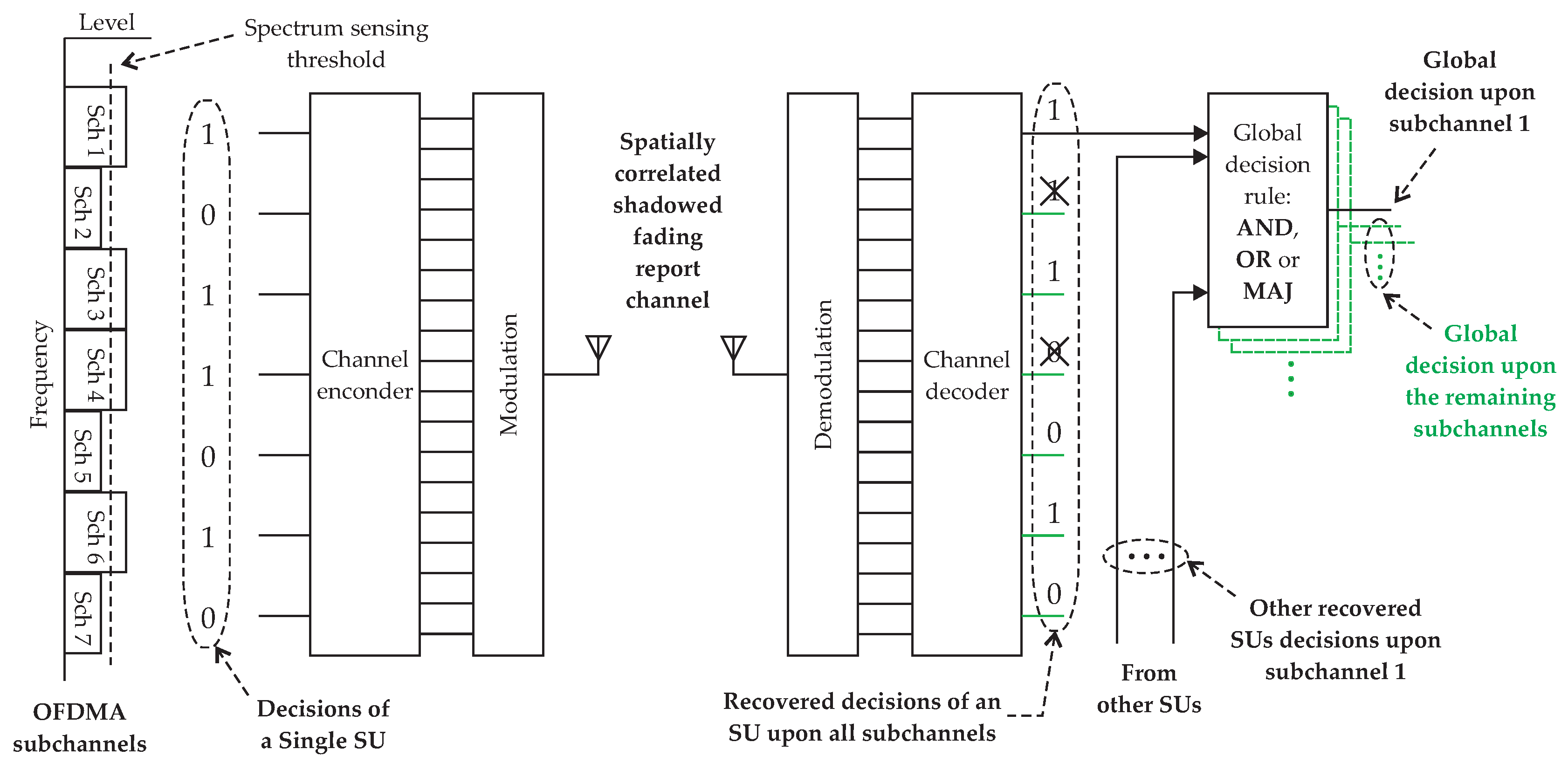
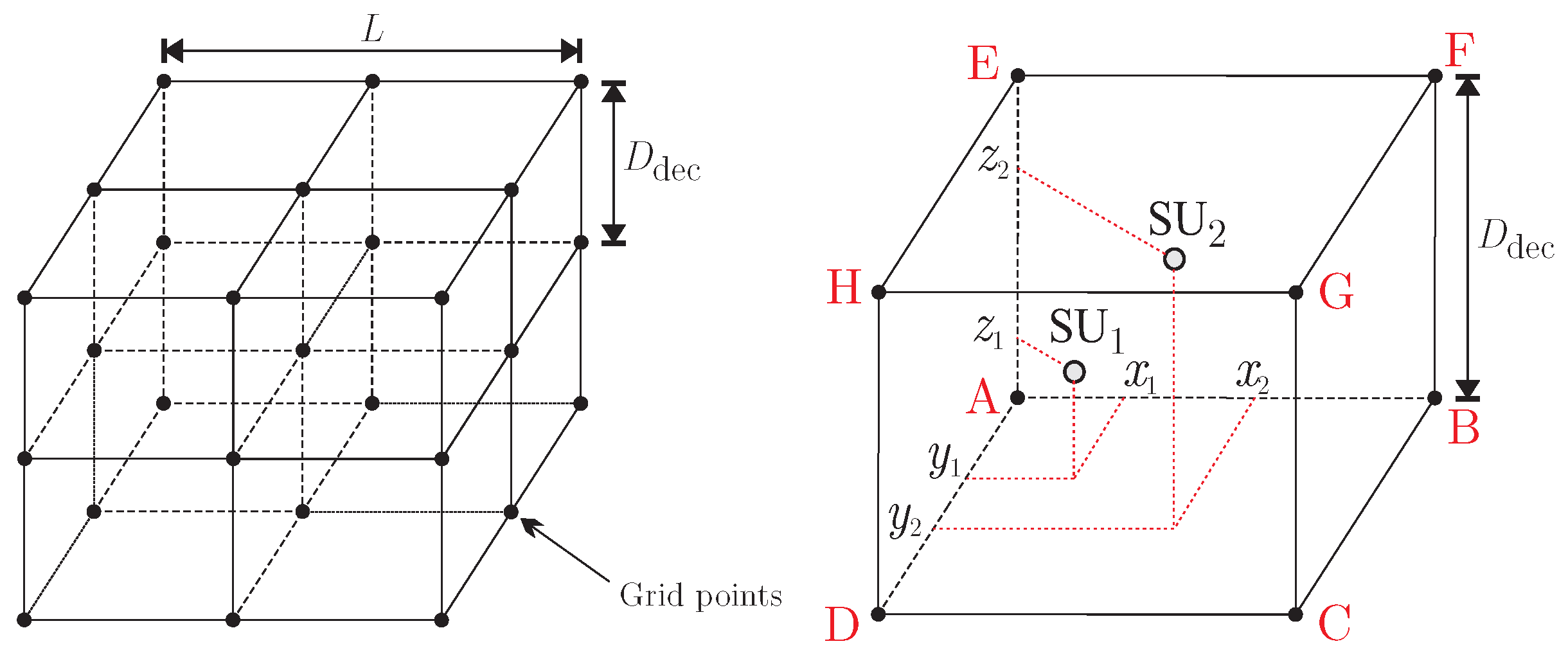
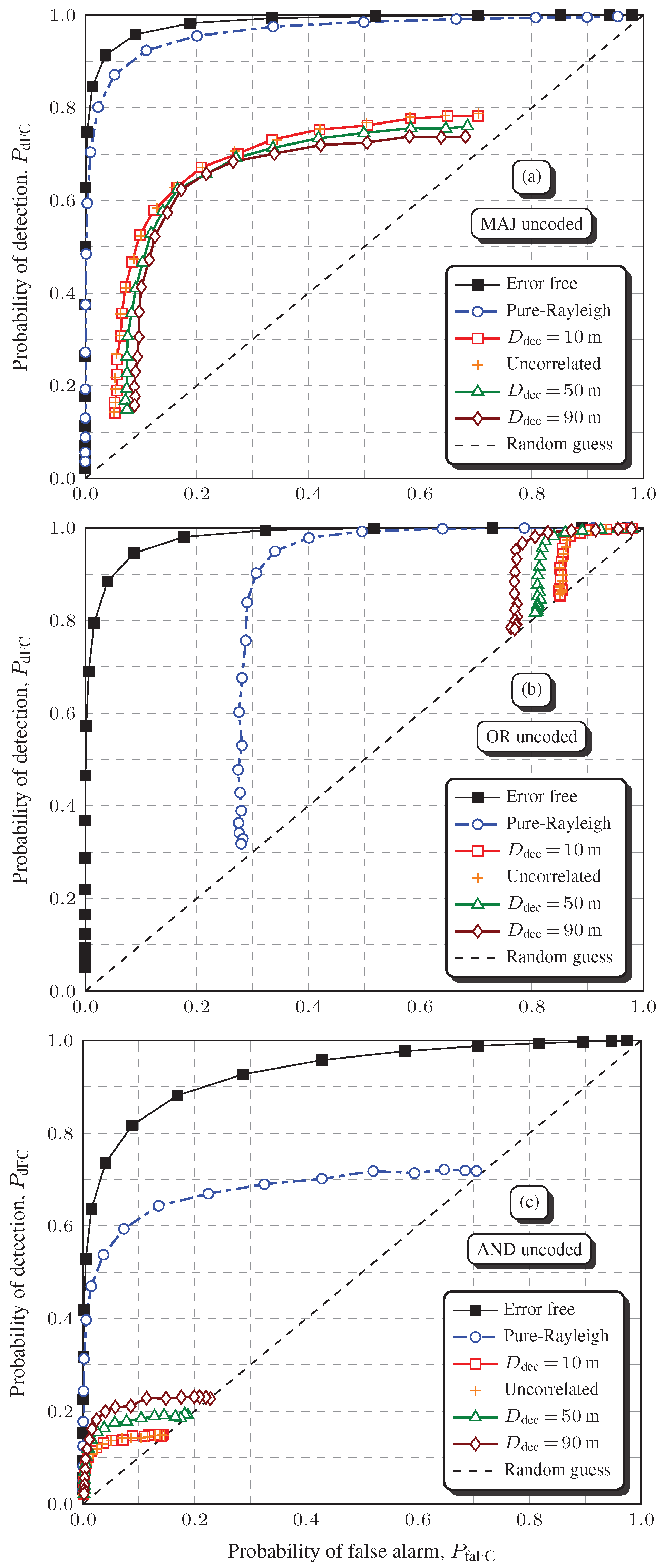
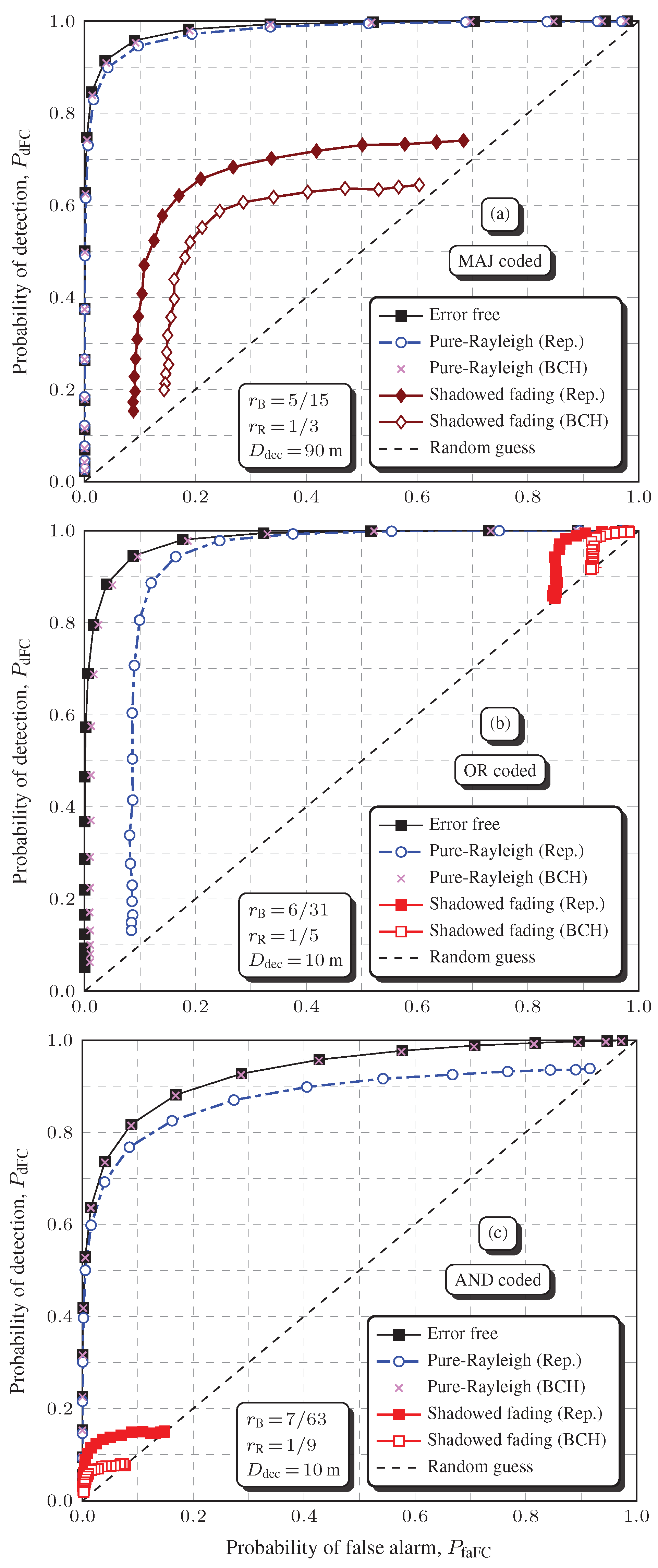
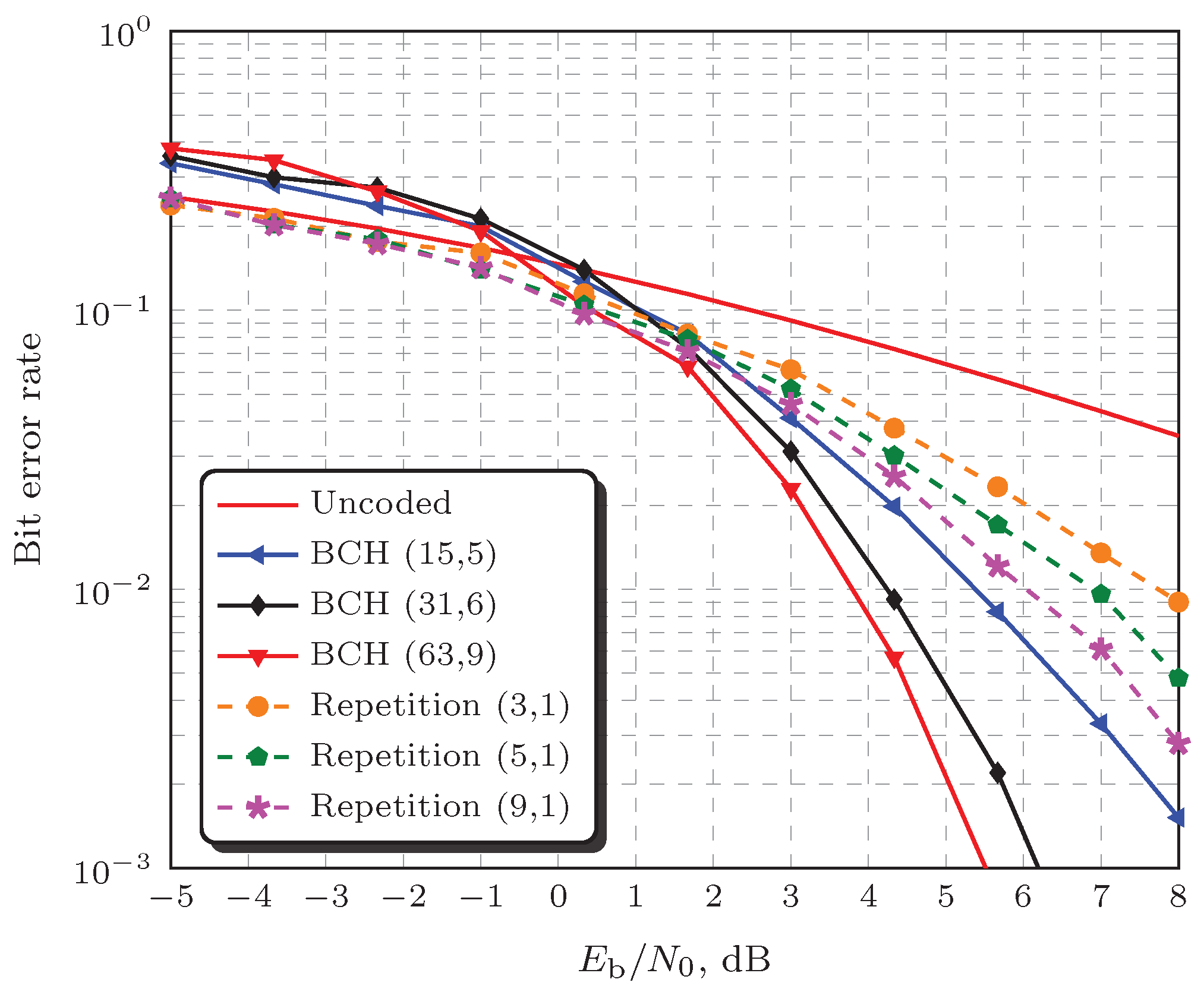
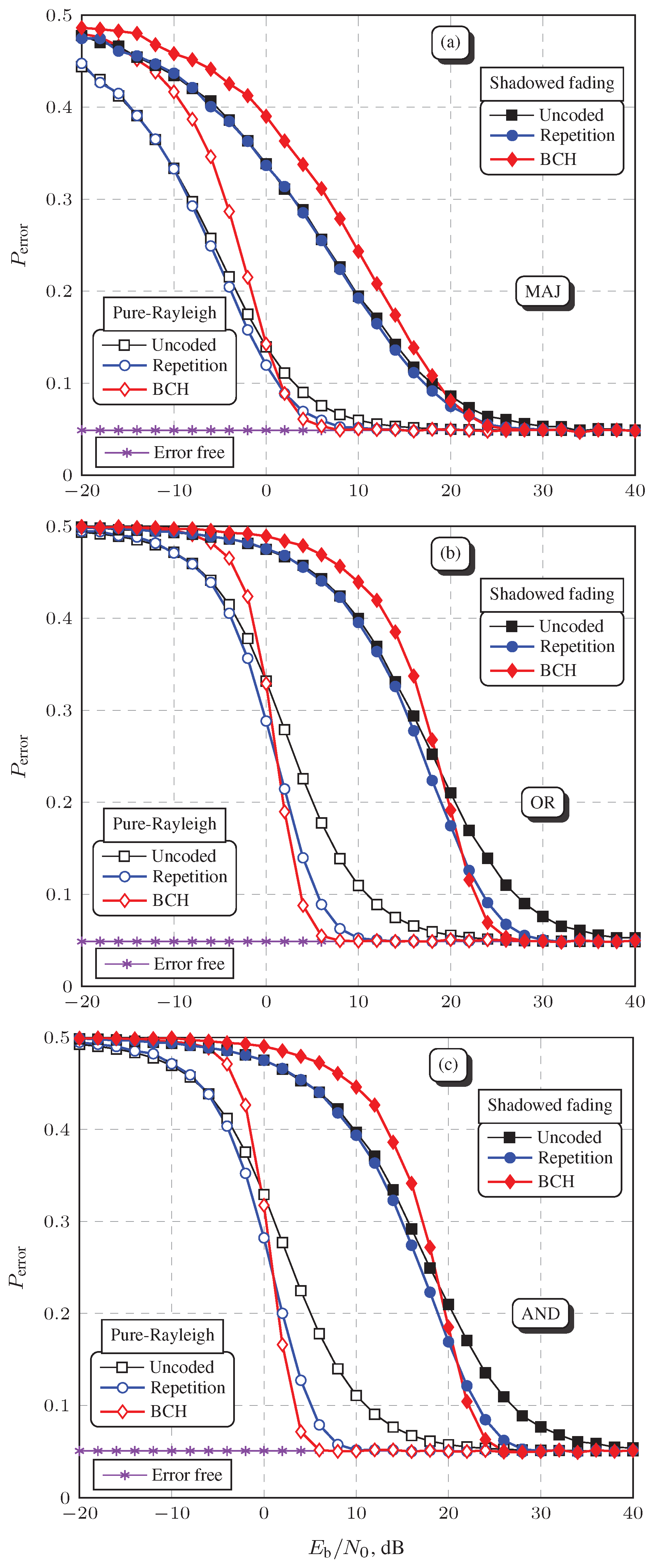
| I.m | |||
| MAJ | OR | AND | |
| II. m | |||
| MAJ | OR | AND | |
| III. m | |||
| MAJ | OR | AND | |
| I.m | |||
| Repetition Code | |||
| MAJ | OR | AND | |
| 6.14 | |||
| 8.68 | |||
| 12.28 | |||
| BCH Code | |||
| MAJ | OR | AND | |
| 6.14 | |||
| 8.68 | |||
| 12.28 | |||
| II. m | |||
| Repetition code | |||
| MAJ | OR | AND | |
| 6.14 | |||
| 8.68 | |||
| 12.28 | |||
| BCH Code | |||
| MAJ | OR | AND | |
| 6.14 | |||
| 8.68 | |||
| 12.28 | |||
| III. m | |||
| Repetition Code | |||
| MAJ | OR | AND | |
| 6.14 | |||
| 8.68 | |||
| 12.28 | |||
| BCH Code | |||
| MAJ | OR | AND | |
| 6.14 | |||
| 8.68 | |||
| 12.28 | |||
© 2018 by the authors. Licensee MDPI, Basel, Switzerland. This article is an open access article distributed under the terms and conditions of the Creative Commons Attribution (CC BY) license (http://creativecommons.org/licenses/by/4.0/).
Share and Cite
Costa, L.d.S.; Guimarães, D.A.; De Souza, R.A.A.; Bomfin, R.C.D.V. Cooperative Spectrum Sensing with Coded and Uncoded Decision Fusion under Correlated Shadowed Fading Report Channels. Sensors 2019, 19, 51. https://doi.org/10.3390/s19010051
Costa LdS, Guimarães DA, De Souza RAA, Bomfin RCDV. Cooperative Spectrum Sensing with Coded and Uncoded Decision Fusion under Correlated Shadowed Fading Report Channels. Sensors. 2019; 19(1):51. https://doi.org/10.3390/s19010051
Chicago/Turabian StyleCosta, Lucas dos Santos, Dayan Adionel Guimarães, Rausley Adriano Amaral De Souza, and Roberto César Dias Vilela Bomfin. 2019. "Cooperative Spectrum Sensing with Coded and Uncoded Decision Fusion under Correlated Shadowed Fading Report Channels" Sensors 19, no. 1: 51. https://doi.org/10.3390/s19010051
APA StyleCosta, L. d. S., Guimarães, D. A., De Souza, R. A. A., & Bomfin, R. C. D. V. (2019). Cooperative Spectrum Sensing with Coded and Uncoded Decision Fusion under Correlated Shadowed Fading Report Channels. Sensors, 19(1), 51. https://doi.org/10.3390/s19010051







